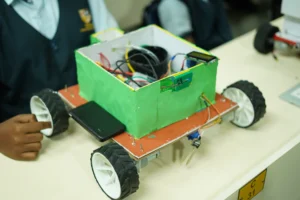We cannot ignore the role of technology in today’s rapidly advancing world. It’s no surprise that educators and parents alike are focusing on equipping children with skills that will prepare them to lead in the future. One of the most impactful and exciting ways to do this is through Robotics Courses, which are not only revolutionizing education but also fostering the development of the next generation of tech leaders. By integrating AI with robotics and exploring AI for robotics, these courses are shaping a future where technology and innovation go hand in hand
Let’s explore how robotics for children is shaping their minds, fostering creativity, and empowering them to be tomorrow’s trailblazers in the tech industry.
The Rising Importance of Robotics in Education
As technology continues to dominate almost every aspect of our lives, the demand for tech-savvy individuals is skyrocketing. Robotics combines multiple disciplines, including science, technology, engineering, and mathematics (STEM), offering children a comprehensive learning experience. By incorporating AI with robotics and exploring AI for robotics, children can gain a deeper understanding of how these technologies are reshaping the future.
Robotics Courses introduce children to these concepts in an interactive and engaging way. By learning to design, build, and program robots, kids gain practical knowledge that goes beyond theoretical learning. This hands-on experience not only nurtures their curiosity but also teaches them essential problem-solving and critical-thinking skills.
Moreover, robotics fosters innovation. In an era where artificial intelligence and automation are reshaping industries, introducing children to robotics early prepares them to adapt to these changes and even lead the charge in creating new technologies. By learning AI with robotics and exploring AI for robotics, children gain the skills to not only understand these advancements but also contribute to shaping the future of technology.
Why Robotics for Children?
- Hands-On Learning
Robotics allows children to learn by doing. Unlike traditional classroom learning, where knowledge is often theoretical, robotics requires kids to apply what they’ve learned to solve real-world problems. This active participation helps them understand concepts better and boosts retention.
For instance, through Robotics Courses, children can learn coding by programming their robots to perform specific tasks, such as navigating a maze or picking up objects. This practical application makes learning both fun and impactful. By integrating AI with robotics and using AI for robotics, children can further enhance their skills, exploring how artificial intelligence can be applied to solve complex challenges in robotics.
- Encourages Creativity and Innovation
Constructing robots encourages children to engage in creative and innovative thinking. They need to come up with unique solutions to design and construct robots that meet specific goals. This fosters creativity and teaches them to approach problems with an innovative mindset. By incorporating AI with robotics, children can explore new possibilities, integrating artificial intelligence into their robots to create smarter and more efficient solutions.
In robotics classes, children are often encouraged to experiment and make mistakes, helping them develop resilience and perseverance—two key traits of successful tech leaders.
- Develops Critical Thinking and Problem-Solving Skills
When building or programming a robot, children often encounter challenges. Whether it’s a mechanical glitch or a coding error, they learn to analyze problems, identify solutions, and implement fixes.
These problem-solving skills are not only essential for robotics but also transferable to other areas of life and education. By participating in Robotics Courses, kids develop the ability to think critically and tackle challenges head-on.
The Role of Robotics in Shaping Future Tech Leaders
The leaders of tomorrow will need more than just technical knowledge; they will also need to understand how to work collaboratively, think strategically, and innovate continuously. Robotics Courses play a pivotal role in developing these skills. By integrating AI with robotics, these courses help children understand how artificial intelligence can enhance collaboration, strategic thinking, and innovation, preparing them to lead in the tech-driven future.
- Teamwork and Collaboration
Many robotics programs require children to work in teams to build and program their robots. This teaches them the importance of collaboration, communication, and teamwork—skills that are crucial for leadership roles.
Through group projects, children learn to share ideas, delegate tasks, and work towards a common goal, preparing them to lead diverse teams in the future.
- Fosters Leadership Qualities
By taking on responsibilities such as project management, troubleshooting, and innovation during robotics projects, children begin to develop leadership skills. They learn to take initiative, guide their peers, and make decisions—qualities that are essential for tech leaders. Through AI with robotics, children can further enhance these leadership skills by applying artificial intelligence to solve real-world problems and lead the way in tech innovation.

ai with robotics
Preparing for Future Careers
Robotics Courses don’t just teach children technical skills; they also prepare them for the careers of the future. With the rise of automation, AI, and robotics, jobs in these fields are expected to grow exponentially in the coming years.
By learning robotics early, children gain a head start in understanding the technologies that will drive the future. They also develop a passion for STEM fields, encouraging them to pursue careers in engineering, computer science, and related disciplines. With AI with robotics, they can explore the integration of artificial intelligence in robotics, enhancing their skills and preparing them for the tech-driven world ahead
Inspiring Real-World Applications
One of the most exciting aspects of robotics for children is the ability to see real-world applications of their work. For example:
Environmental Robotics: Kids can design robots to clean up trash from beaches or plant trees, inspiring them to tackle environmental challenges.
Healthcare Robotics: Children can create robots that assist people with disabilities, introducing them to the humanitarian side of technology.
Space Exploration: Robotics Courses can spark an interest in space technology, inspiring children to work on innovations for space exploration.
When children see how their creations can make a difference, they are motivated to push boundaries and think about how technology can solve global challenges.
Robotics for All: Breaking Barriers
One of the most significant advantages of robotics education is its inclusivity. Robotics Courses are designed to be accessible to children of all skill levels, making technology education more equitable.
Programs often use tools and platforms tailored for beginners, such as Lego Mindstorms or Scratch-based coding, ensuring that even young learners can participate. As children grow and gain confidence, they can progress to more advanced robotics challenges, allowing for continuous learning and development. By incorporating AI with robotics, these programs help children understand how artificial intelligence can be applied to robotics, advancing their skills and knowledge as they take on more complex projects
Encouraging Girls in Robotics
Despite progress in gender equality, STEM fields still face a gender gap. Robotics Courses are actively working to change this by encouraging more girls to participate.
Through initiatives such as girls-only robotics teams or female mentors in robotics education, these programs aim to inspire young girls to pursue STEM careers and become tech leaders.
By fostering diversity, robotics education ensures that the leaders of tomorrow represent a wide range of perspectives and ideas, leading to more inclusive and innovative solutions. Through AI with robotics, children from diverse backgrounds can explore how artificial intelligence enhances robotics, contributing to the development of creative and groundbreaking technologies
How Parents Can Support Robotics Education
As a parent, you have a vital role in fostering your child’s curiosity and enthusiasm for robotics. Here’s how you can support them:
Enroll Them in Robotics Courses: Look for programs that align with your child’s age and skill level. Many courses are available online, making them convenient and accessible.
Provide Tools and Resources: Invest in beginner-friendly robotics kits or encourage your child to participate in robotics competitions.
Allow them to Experiment and Explore: Let your child explore and experiment as much as they want. Let them make errors. Better, let them grasp things at their own comfortable pace. Acknowledge and celebrate their efforts, no matter the result. By experimenting with AI with robotics, children can deepen their understanding of how artificial intelligence works alongside robotics, enhancing their learning experience and encouraging innovation through hands-on exploration
Expose Them to Role Models: Introduce your child to inspiring tech leaders or mentors in robotics to show them what’s possible.
A Bright Future Ahead
The integration of robotics into education is more than just a trend; it’s a transformative approach to preparing children for the challenges and opportunities of the future. By enrolling kids in Robotics Courses, we are not only equipping them with technical skills but also empowering them to think critically, innovate fearlessly, and lead confidently.
The children who master robotics today will be the tech leaders of tomorrow—individuals who shape industries, solve global problems, and create a brighter, more sustainable future for all.
Investing in robotics for children isn’t just an investment in their education; it’s an investment in the future of technology, innovation, and leadership. Let’s take this step together and build a generation of tech-savvy, forward-thinking leaders ready to change the world. By offering robotics for kids, we provide them with the tools to explore technology, spark creativity, and develop the skills needed to thrive in an ever-evolving digital world.
Robotics is no longer just a subject; it’s a pathway to possibilities. Let’s ensure every child has access to this powerful tool for learning and growth. After all, the future belongs to those who are ready to create it. By adding a machine learning course alongside robotics, children can deepen their understanding of how artificial intelligence and automation work together, preparing them to shape the future of technology

